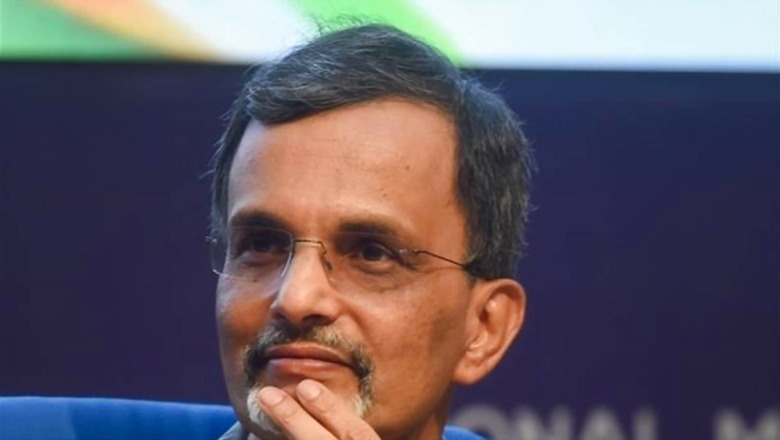
views
“This is not about Washington economics, this is actually about Indian middle-class economics so as to have sustainable finances for households and the government,” the Centre’s chief economic adviser (CEA) V Anantha Nageswaran said in Bengaluru on Friday, strongly defending the country’s recent fiscal moves.
Speaking at an event of the India Foundation, Nageswaran also said that the nation was “better placed than most countries in the coming years to deliver domestically driven growth” and that the move on privatisation and asset monetisation was a paradigm shift after over two decades.
He said that to deliver the kind of growth rate that would take India to a state of a middle-income economy in the next 20 years, it needs a vibrant financial sector that is capable of providing the funds required for development.
“Thankfully, in that sense, we had gone through a difficult phase in the last decade. The banking system had over-lent, the corporate sector had over-borrowed and we spent the bulk of the last decade cleaning up balance sheets everywhere — in the financial system and the corporate system. That is why in this decade, as central banks around the world tighten monetary policy, India is better placed than most countries. Because we are paying our share of growth dues of the last decade as the financial sector was rebuilding. We are in a position to deliver domestically driven growth — that is one important thing,” Nageswaran said.
Privatisation and asset monetisation
The CEA said that even as the Covid pandemic was unfolding, the government had used the crisis as an opportunity. “To deliver structural reforms, industrial policy, incentive schemes, the rational corporate tax rates, rules regarding start-ups and business were simplified, retro tax ended and after a gap of more than 20 years, India has reembarked on privatisation. This has not been attempted in the last two decades,” he said.
Nageswaran said the Air India privatisation was a milestone exercise and an important paradigm shift. “The asset monetisation scheme basically improves the balance sheet of the government. As we retire assets and pass them onto private hands, we will also extinguish liabilities and bring down debt ratios and bring down the cost of capital for the private sector,” Nageswaran said.
He said it was very important to focus on fiscal prudence and fiscal sustainability. “This is not about Washington economics, this is actually about Indian middle-class economics so as to have sustainable finances for households and the government,” said the CEA.
Responsible economics
Nageswaran said it is all about “responsible economics” as one moves ahead, and the same must be on part of all systems of government — local, central, state, as well as the private sector. “For the government, there have to be five factors. Fiscal prudence, reforming the power sector so that discoms are viable and making sure that we do not have to worry about availability of coal as raw material for power generation,” the CEA said.
He also said that the “government as a litigant should be the last resort”, and advised that with school education being badly affected due to shutdown in the last two years, making up for the same is important. “What I hear from many is that students are displaying attention deficiency and impairment of social skills — this may have a medium-term impact on learning new skills. Making up for these two years is also a part of responsible economics,” the CEA said.
He said responsible economics also is about the private sector which invests little in research and development (R&D), which is vital if “India has to become a meta economy in the next 25 years. Manufacturing complexity has to increase. Private sector has to do much more”.
He also flagged the attitude towards public health saying latest government surveys showed the obesity level of Indian adults is concerning. “It used to be said that China will become grey before it becomes rich. In India, I don’t want it to be a situation where India becomes unhealthy before it becomes rich. The private sector should ensure food labelling, which is very important to warn people about what they are consuming,” he said.
Nagewaran also said that the private sector must ensure that it pays MSMEs (micro, small and medium enterprises) on time.
Indian economic transitions
The CEA said the Indian economy has gone through multiple transitions in the last 70 years, with the first whiff of economic liberalisation under then finance minister R Venkataraman in the 1980s, and the massive liberalisation of the economy in 1991.
“In 2004, we had a new government that focussed on enacting many social entitlement schemes and packaged them as empowerment and constitutional rights — like the right to food, education, and employment guarantee in rural India. This was Indian Economy 2.5,” he said.
“In 2014 — the NDA came to office and this government made an attempt to reform the factor markets — land and labour. And there was also a belief in the formalisation of the economy and we have seen in 2019 an affirmation of that. Formalisation opens the doors for finance and small, micro, medium enterprises. Reform of the factor markets and formalisation of the economy — this was Economy 3.0,” the CEA said.
“Then came from 2015-16 onward the harnessing of public digital goods — Aadhaar, Jan Dhan, GST, and unified payment system. This is taking tech to a different level. Unlike in the US, where technologies were developed by the private sector and their fruits stayed in the hands of a few entrepreneurs, in India, these technical backbone and foundations have been developed as public digital goods. India’s digital goods reform or platform actually constitutes Economy 4.0,” he said.
“Right now as we are entering hopefully the post-pandemic era, the Indian economy is poised for its fourth edition and this will shape the future of this country for the next 25 years,” the CEA said.
Nageswaran cited a recent Economist magazine article saying it came out with grudging praise and outlines certain elements of how the economy will shape up in India. “They identified four pillars that will support growth in the next decade. A single national market — GST. Expansion of industry moving to renewable energy, and move of supply chains away from China. And a high-tech welfare safety net for hundreds of millions enabled by tech without leakages,” he said.
Read all the Latest India News here



















Comments
0 comment